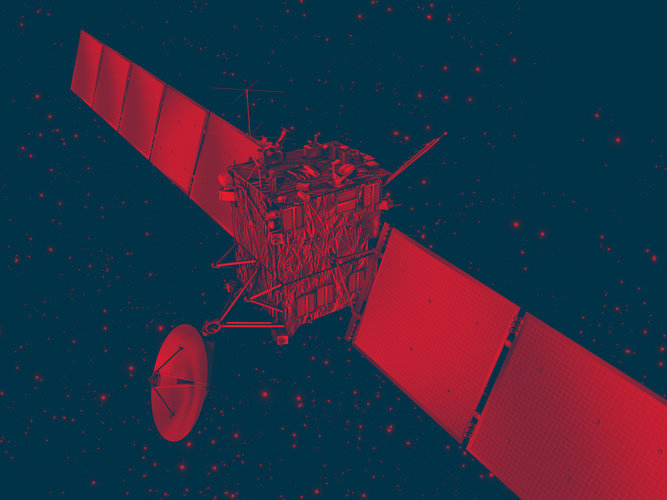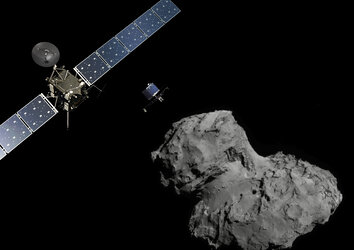Rosetta at a glance
Rosetta is the first mission designed to both orbit and land on a comet. Rosetta comprises an orbiter and a lander. The spacecraft carries eleven scientific experiments to complete the most detailed study of a comet ever attempted.
Rosetta's name comes from the famous Rosetta stone, that almost 200 years ago led to the deciphering of Egyptian hieroglyphics. In a similar way, scientists hope that the Rosetta spacecraft will unlock the mysteries of how the Solar System evolved.
Launch
26 February 2004
Launcher
Ariane 5
Spacecraft launch mass
Approximately 3000 kg (fully fuelled) including 1670 kg of propellant, 165 kg of scientific payload for the orbiter and 100 kg for the lander.
Dimensions
Main spacecraft 2.8 x 2.1 x 2.0 m, on which all subsystems and payload equipment are mounted. Two 14 m solar panels with a total area of 64 sq. m.
Cost
Around 1000 million Euro (including the scientific instruments funded by national agencies)
Orbit
Interplanetary, out to 5.25 AU (about 790 million km from the Sun).
Payload - Orbiter
| ALICE: | Ultraviolet Imaging Spectrometer (S. A. Stern, SwRI, Boulder, Co., USA) |
| CONSERT: | Comet Nucleus Sounding (W. Kofman, LPG, Grenoble, France) |
| COSIMA: | Cometary Secondary Ion Mass Analyser (J. Kissel, MPE, Garching, Germany) |
| GIADA: | Grain Impact Analyser and Dust Accumulator (L Colangeli, Oss. Astronomico di Capodimonte , Naples, Italy) |
| MIDAS: | Micro-Imaging Analysis System (W. Riedler, IWF, Graz, Austria) |
| MIRO: | Microwave Instrument for the Rosetta Orbiter (S. Gulkis, NASA-JPL, Pasadena, Ca., USA) |
| OSIRIS: | Rosetta Orbiter Imaging System (H.U. Keller, MPAe, Katlenburg-Lindau, Germany) |
| ROSINA: | Rosetta Orbiter Spectrometer for Ion and Neutral Analysis (H. Balsiger, Univ. of Bern, Switzerland) |
| RPC: | Rosetta Plasma Consortium (A. Eriksson, Swedish Institute of Space Physics, Uppsala, Sweden; J. Burch, SwRI, San Antonio, Tx., USA; K-H Glassmeier, TU Braunschweig, Germany; R. Lundin, Swedish Institute of Space Physics, Kiruna, Sweden; J. G. Trotignon, LPCE/CNRS, Orleans, France; C. Carr, Imperial College, UK) |
| RSI: | Radio Science Investigation (M. Pätzold, Univ. Cologne, Cologne, Germany) |
| VIRTIS: | Visible and Infrared Mapping Spectrometer (A. Coradini, IASFC, Rome, Italy) |
Payload - Lander
| APXS: | Alpha Proton X-ray Spectrometer (R. Rieder, MPCH, Mainz, Germany) |
| ÇIVA / ROLIS: | Rosetta Lander Imaging System (J. P. Bibring, IAS, Orsay, France; S. Mottola, DLR, Berlin,Germany) CONSERT – Comet Nucleus Sounding (W. Kofman, LPG, Grenoble, France) |
| COSAC: | Cometary Sampling and Composition experiment (H. Rosenbauer, MPAe, Katlenburg-Lindau, Germany) |
| MODULUS PTOLEMY: | Evolved Gas Analyser (I.Wright, Open University, UK) |
| MUPUS: | Multi-Purpose Sensor for Surface and Subsurface Science (T. Spohn, Univ. of Münster Germany) |
| ROMAP: | RoLand Magnetometer and Plasma Monitor (U. Auster, DLR, Berlin, Germany; I. Apathy, KFKI, Budapest, Hungary) |
| SD2: | Sample and Distribution Device (A. Ercoli Finzi, Polytecnico, Milano, Italy) |
| SESAME: | Surface Electrical and Acoustic Monitoring Experiment, Dust Impact Monitor (D. Möhlmann, DLR, Cologne,Germany; W. Schmidt, FMI, Helsinki, Finland; I. Apathy, KFKI, Budapest, Hungary) |
Operations
Mission Operations Centre: European Space Operations Centre (ESOC), Darmstadt, Germany
Prime Ground Station: New Norcia, near Perth, Australia
Science Operations Centre: Co-located at ESOC (Darmstadt, Germany) and ESTEC (Noordwijk, Netherlands)
Lander Control Centre: DLR, Cologne, Germany
Lander Science Centre: CNES, Toulouse, France
Planned Operational Duration: 12 years






